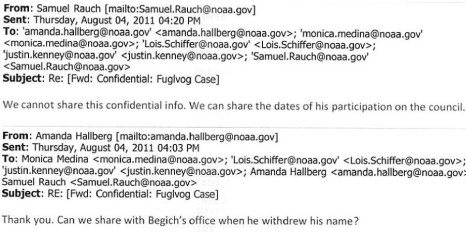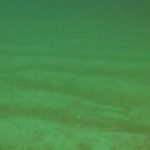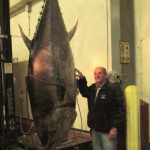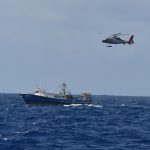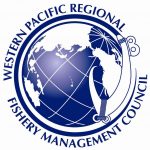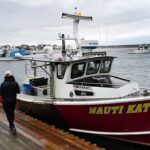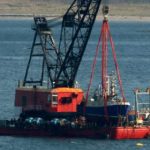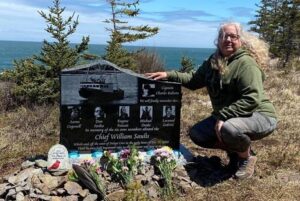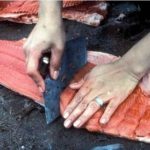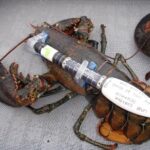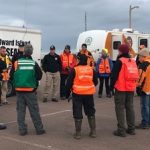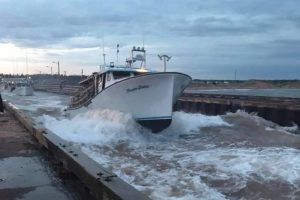Tag Archives: North Pacific Fisheries Management Council
Unalaska pushes back against proposed bycatch restrictions on pollock fishery
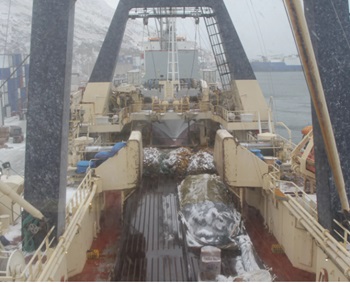 Unalaska leaders are pushing back against a proposed petition to eliminate Chinook bycatch in the Bering Sea Alaska pollock fishery. Nearly 100 tribes and communities in western Alaska, including the Association of Village Council Presidents, signed an emergency petition that would set a zero-bycatch limit on Chinook salmon in the pollock trawl fishery for 180 days. Unalaska Mayor Vince Tutiakoff Sr. said in a letter that a zero-cap would “effectively shut down the entire pollock fishery of the Bering Sea,” and create a “dire situation” for Unalaska. links, more, ??click to read<< 11:19
Unalaska leaders are pushing back against a proposed petition to eliminate Chinook bycatch in the Bering Sea Alaska pollock fishery. Nearly 100 tribes and communities in western Alaska, including the Association of Village Council Presidents, signed an emergency petition that would set a zero-bycatch limit on Chinook salmon in the pollock trawl fishery for 180 days. Unalaska Mayor Vince Tutiakoff Sr. said in a letter that a zero-cap would “effectively shut down the entire pollock fishery of the Bering Sea,” and create a “dire situation” for Unalaska. links, more, ??click to read<< 11:19
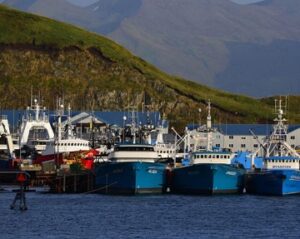
Regardless of party or office, Alaska candidates are targeting trawling
Republicans, Democrats and independents seeking a variety of elected offices across Alaska appear united by a desire to restrict deep-sea trawling. In candidate questionnaires submitted to the Alaska Beacon, candidates for statewide and legislative races, regardless of party, say the restrictions are the best way to improve salmon returns on the Yukon and Kuskokwim rivers. “I support efforts to reduce the wasteful bycatch of Alaska’s seafood by Seattle-based high seas fishing corporations,” said Mary Peltola, the Democratic candidate for Alaska’s U.S. House seat. “Science provides the best guide. However, I think most Alaskans agree it is past time to get high seas trawler bycatch under control,” said Tuckerman Babcock, a Republican candidate for an Alaska Senate district on the Kenai Peninsula. >click to read< 19:46

Bycatch task force works to refine mission ahead of November deadline
Bycatch is when fishing vessels catch something they’re not targeting. It could be tanner crab caught in a black cod pot, or halibut scooped up in a pollock trawl net. It’s been an incendiary issue in Alaska’s fisheries for decades. Now, as stocks of crab, salmon and halibut decline, trawl fisheries have come under fire for their role, which represents the vast majority of incidental catch in and around Alaska. The governor’s office took notice. Gov. Mike Dunleavy established a task force to review bycatch late last year with a deadline of November to submit its recommendations. But during that time, the Alaska Bycatch Review Task Force also has to establish its own priorities, break into subcommittees, and decide what it’s going to focus on before its mandate expires in just nine months. And there’s a lot of information to sort through already as it plays catch-up. >click to read< 11:01
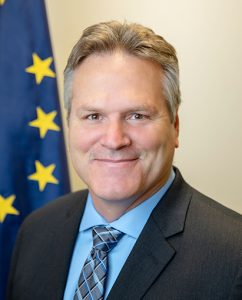
Dunleavy’s super-special election year bycatch task force – Bycatch is on the ballot.
Gov. Mike Dunleavy recently announced the formation of a shiny new “task force,” charged with studying the impacts of bycatch on Alaska fisheries and making recommendations to policy makers. The Alaska Department of Fish and Game has supposedly been doing exactly this for nearly half a century with its permanent voting seat on the North Pacific Fisheries Management Council, or NPFMC. >click to read< By Alexus Kwachka 17:12
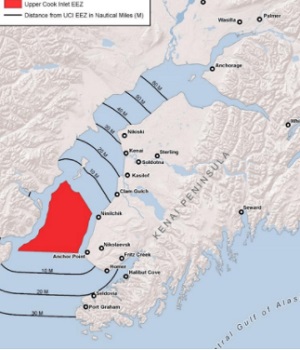
Opposition mounts to proposal to close part of Cook Inlet to salmon fishing
The southern half of Cook Inlet will have a new fishery management plan in under a month. Commercial fishermen are organizing with the help of their city councils to make sure that plan is not the proposed “Alternative 4,” which would close off federal waters south of Kalgin Island to commercial salmon fishing. “I hate to be overdramatic in a lot of cases, but you could almost call it a deathknell for drift fishing in Cook Inlet,” he said. The North Pacific Fisheries Management Council is taking public comment on the matter until 5 p.m. Friday. As of Monday, over 80 commenters had voiced opposition to Alternative 4,,, >click to read< 11:32
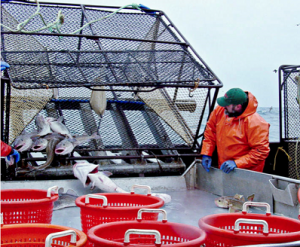
Extremely low cod numbers lead feds to close the Gulf of Alaska fishery for the first time
A stock assessment this fall put Gulf cod populations at a historic low, with “next to no” new eggs, according to National Oceanic and Atmospheric Administration research biologist Steve Barbeaux, who authored the report. At their current numbers, cod are below the federal threshold that protects them as a food source for endangered Steller sea lions. Once below that line, the total allowable catch goes to zero — in other words, the fishery shuts down. >click to read< 08:32

Bristol Bay fishermen renew call for input on Pebble Mine as commercial fishing season opens
Commercial fishing season is underway in Bristol Bay; but instead of focusing all their attention on their catches, fishermen are focused on the future the Pebble Mine could have on their livelihood. The public comment period on the Draft Environmental Impact Statement closes July 1. “Our industry in Bristol Bay is in the fight of our lives against relentless attempts by the Pebble Limited Partnership, fueled by a ‘dig baby dig’ attitude from the US Army Corps of Engineers, to develop the world’s largest and most dangerous open pit mine at the headwaters of our fishery,” >click to read<. a lot of info, and some links to comment. 16:55
Fish Politics – Victim of the state
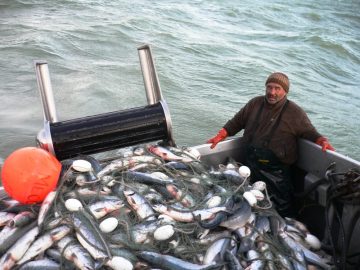 Once revered for world-leading skills at managing wild salmon, the Alaska Department of Fish and Game today finds itself under attack as incompetent as the North Pacific Fisheries Management Council begins court-ordered consideration of salmon management in the federal waters of Cook Inlet. The most powerful commercial fishing organization in the 49th state’s most populated region says its members have been robbed of $33 million over the past six years thanks to state mismanagement of salmon, and they want the federal government to make things right. The United Cook Inlet Drift Association forced the management issue into federal court hoping to get its nets around more salmon. It now accuses Fish and Game’s Commercial Fisheries Division of grossly mismanaging runs bound for the Kenai, Kasilof and Susitna rivers for years.,,The state rebuilt them to record levels, but along the way the politics of fish changed. click here to continue this Big Read 10:55
Once revered for world-leading skills at managing wild salmon, the Alaska Department of Fish and Game today finds itself under attack as incompetent as the North Pacific Fisheries Management Council begins court-ordered consideration of salmon management in the federal waters of Cook Inlet. The most powerful commercial fishing organization in the 49th state’s most populated region says its members have been robbed of $33 million over the past six years thanks to state mismanagement of salmon, and they want the federal government to make things right. The United Cook Inlet Drift Association forced the management issue into federal court hoping to get its nets around more salmon. It now accuses Fish and Game’s Commercial Fisheries Division of grossly mismanaging runs bound for the Kenai, Kasilof and Susitna rivers for years.,,The state rebuilt them to record levels, but along the way the politics of fish changed. click here to continue this Big Read 10:55
Greenpeace claims on coral refuted by NOAA’s more accurate technology
 The study was conducted to help inform the North Pacific Fisheries Management Council (NPFMC) of the state of coral in the Pribilof Canyon in the Bering Sea off the coast of Alaska and whether it was threatened by pollock fishing in the area, before they made their decision earlier this month to continue to allow fishing there. “[During NOAA’s] camera study, we scattered camera drops everywhere along the slope, we weren’t [focused on] any location, to map where corals are found. We sent cameras down 250 times [in one month], compared to the Greenpeace study, [which sent] 30,” Sigler said. Read the rest here 14:46
The study was conducted to help inform the North Pacific Fisheries Management Council (NPFMC) of the state of coral in the Pribilof Canyon in the Bering Sea off the coast of Alaska and whether it was threatened by pollock fishing in the area, before they made their decision earlier this month to continue to allow fishing there. “[During NOAA’s] camera study, we scattered camera drops everywhere along the slope, we weren’t [focused on] any location, to map where corals are found. We sent cameras down 250 times [in one month], compared to the Greenpeace study, [which sent] 30,” Sigler said. Read the rest here 14:46
NPFMC Bering Sea fishing decision based on science, not bias
 This week, the North Pacific Fisheries Management Council (NFPMC) ruled that it will not be placing a limit on trawl fishing in the Bering Sea’s Pribilof and Zhemchug canyons, despite claims by various NGOs that the practice places vulnerable coral in danger there. Greenpeace, taking the lead on the NGO protests of the NFPMC’s decision, suggested that the council was catering to fishing industry special interests; however,,, Read the rest here 13:39
This week, the North Pacific Fisheries Management Council (NFPMC) ruled that it will not be placing a limit on trawl fishing in the Bering Sea’s Pribilof and Zhemchug canyons, despite claims by various NGOs that the practice places vulnerable coral in danger there. Greenpeace, taking the lead on the NGO protests of the NFPMC’s decision, suggested that the council was catering to fishing industry special interests; however,,, Read the rest here 13:39
Halibut bycatch cap reduction should reflect what we know about the resource
 As a fishery scientist who has worked for more than 20 years with trawl fishermen to reduce salmon, crab and halibut bycatch, I find the recent rhetoric around proposed North Pacific Fisheries Management Council changes to the cap very frustrating. In particular, I hear media campaigns underwritten by environmental NGOs claiming, “It’s been 20 years since the halibut bycatch cap was last reduced,” implying that this has created a conservation issue. Read the rest here 14:28
As a fishery scientist who has worked for more than 20 years with trawl fishermen to reduce salmon, crab and halibut bycatch, I find the recent rhetoric around proposed North Pacific Fisheries Management Council changes to the cap very frustrating. In particular, I hear media campaigns underwritten by environmental NGOs claiming, “It’s been 20 years since the halibut bycatch cap was last reduced,” implying that this has created a conservation issue. Read the rest here 14:28
Halibut bycatch issue: A poster child for complex fisheries policy in Alaska
 What a conundrum. How does the North Pacific Fisheries Management Council respond to the proposed 50 percent reduction of halibut bycatch in the Bering Sea/Aleutian Islands groundfish fishery requested by halibut fishermen in the region, without significantly impacting the Amendment 80, Trawl and Freezer Long Line vessels in their stead? Regardless how you look at it or what your personal involvement in any of the above fisheries is, major policy shifts in any of the multiple fisheries in the Bering Sea can absolutely impact,,, Read the rest here 12:08
What a conundrum. How does the North Pacific Fisheries Management Council respond to the proposed 50 percent reduction of halibut bycatch in the Bering Sea/Aleutian Islands groundfish fishery requested by halibut fishermen in the region, without significantly impacting the Amendment 80, Trawl and Freezer Long Line vessels in their stead? Regardless how you look at it or what your personal involvement in any of the above fisheries is, major policy shifts in any of the multiple fisheries in the Bering Sea can absolutely impact,,, Read the rest here 12:08
US pollock fleet faces reduced chinook salmon bycatch shutdown level
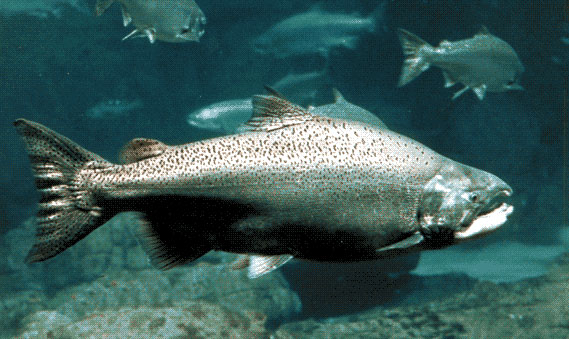 US pollock catchers are set for more restrictive chinook salmon bycatch limits, after a unanimous vote on a motion during the North Pacific Fisheries Management Council (NPFMC) on Saturday. The decline in returns of chinook salmon since 2007 means a lowering of the cap was expected by the industry. A reduction by as much as 60% was being discussed, however, so the level agreed is not as bad as some thought. Read the rest here 09:00
US pollock catchers are set for more restrictive chinook salmon bycatch limits, after a unanimous vote on a motion during the North Pacific Fisheries Management Council (NPFMC) on Saturday. The decline in returns of chinook salmon since 2007 means a lowering of the cap was expected by the industry. A reduction by as much as 60% was being discussed, however, so the level agreed is not as bad as some thought. Read the rest here 09:00
North Pacific Council Meeting in Anchorage December 8 -16, 2014 Listen Live with Adobe Connect!
 The Agenda and Schedule From This Notice are available by clicking here For Adobe Connect to listen, click here 18:34
The Agenda and Schedule From This Notice are available by clicking here For Adobe Connect to listen, click here 18:34
Commerce Secretary asked to cut by-catch of salmon in the Bering sea–Aleutian Islands Pollock fishery
T–C–C officials said the Chinook salmon stocks are crashing, and they need to do everything possible to reverse the trend. The petition asks for an order to reduce the Chinook Salmon by–catch in the Bering sea–Aleutian Islands Pollock fishery. It would cut by–catch from 60 thousand down to 20 thousand. Read the rest here 23:22
Canada’s trawlers drastically cut bycatch, why can’t Alaska’s?
 Sometimes there’s big money to be made prolonging a problem. One short sentence sums up nearly 20 years of work by the North Pacific Fisheries Management Council on trawl bycatch. During the February 1997 meeting of the NPFMC a representative from the Canadian Department of Fisheries and Oceans gave a presentation on how that country reduced trawl bycatch while catching ALL of its trawl quota. Read more here 18:00
Sometimes there’s big money to be made prolonging a problem. One short sentence sums up nearly 20 years of work by the North Pacific Fisheries Management Council on trawl bycatch. During the February 1997 meeting of the NPFMC a representative from the Canadian Department of Fisheries and Oceans gave a presentation on how that country reduced trawl bycatch while catching ALL of its trawl quota. Read more here 18:00
Walleye Pollock – A bounty of fish: Questions about sustainability

It sounds too good to be true: There are so many fish that Seattle-based boats haul in more than a million metric tons of them every year without depleting the population. “It still boggles my mind how much is a million tons of fish,” says David Fluharty, an associate professor at the University of Washington School of Marine and Environmental Affairs. “To actually catch that much protein . . .”more@crosscut 07:17
New Gulf of Alaska king salmon bycatch limits passed by North Pacific Fisheries Management Council
There was almost certainly going to be a cap. All the other trawl fisheries had one, and concern over the health of Alaska’s chinook runs has only increased in recent years. The question was just how much chinook salmon could the Gulf’s trawl fleet take unintentionally before they would have to pull up their nets and stop fishing, period. continued @ APRN – Juneau
North Pacific council makes observer program recommendations
 The motion asked for certain updates to the 2014 deployment plan, suggested information the council would like to see in future reports from the National Marine Fisheries Service, or NMFS, and adopted the agency’s strategic plan for electronic monitoring, or EM. The council’s motion was largely in line with the recommendations from the Observer Advisory Committee, or OAC, and came after significant public testimony. continued @ Alaska Journal
The motion asked for certain updates to the 2014 deployment plan, suggested information the council would like to see in future reports from the National Marine Fisheries Service, or NMFS, and adopted the agency’s strategic plan for electronic monitoring, or EM. The council’s motion was largely in line with the recommendations from the Observer Advisory Committee, or OAC, and came after significant public testimony. continued @ Alaska Journal
Council hears agency, public feedback on marine observer program – Much of today’s discussion at the North Pacific Fishery Management Council revolved around the restructured marine observer program and work towards an electronic monitoring option. continued here
Gulf of Alaska Groundfish Ratz: Kodiak assemblies’ letter misses the protective mark by Stephen Taufen
January 26, 2013
In December, the Federal Register declared that the North Pacific Fisheries Management Council is proceeding on giving away federal fish resources to selected trawl recipients in the Gulf of Alaska. Homer, Kodiak, King Cove and Sand Point are among the most affected — all challenged to economically protect their fishery dependent coastal municipalities and boroughs.
The local city of Kodiak and the Kodiak Island Borough’s joint fishery work group has shown concern and help many meetings over the past seven months, listening to input from all sides. One must applaud when elected officials get highly involved; but that is only if they truly keep the public’s interests foremost. They could take a lesson from New Bedford’s former Mayor Lang’s firm stance about preserving fishing jobs and protecting the local economy against privatization forces. Read more
Western Gulf fishermen join discussion on catch sharing
Come February, a federal fisheries council will continue to discuss catch-sharing programs in Alaska trawl fisheries – this time with a bigger voice from southwest fishermen. This winter the North Pacific Fisheries Management Council (NPFMC) has heard from concerned parties in the state’s south central ground fisheries, regarding a change over to catch sharing. Read more
Southcentral Alaska halibut anglers may face bag limit cuts by 2014 – Alaska Dispatch
Once more the North Pacific Fisheries Management Council, a government entity dominated by commercial fishermen, has voted to slash the halibut catch of charter anglers in Alaska. What happens next remains to be seen. A similar council action was vetoed by the National Oceanic Atmospheric Administration (NOAA) last year after,,,,,,,,,,,unities have mainly suffered because of cuts in the commercial fishery tied to unexplained declines in halibut in the North Pacific. Soaring prices for commercially caught halibut have only partially ,,,,,,,the federal government created what are called “individual fishing quotas” and gave commercial fishermen shares of the halibut resource, those shares have been bought and ,,,,,,,the University of Washington warned that the shifts in IFQ shares were gutting the economies of the smallest coastal communities on Kodiak Island. A similar phenomenon has ,,,,Read More






